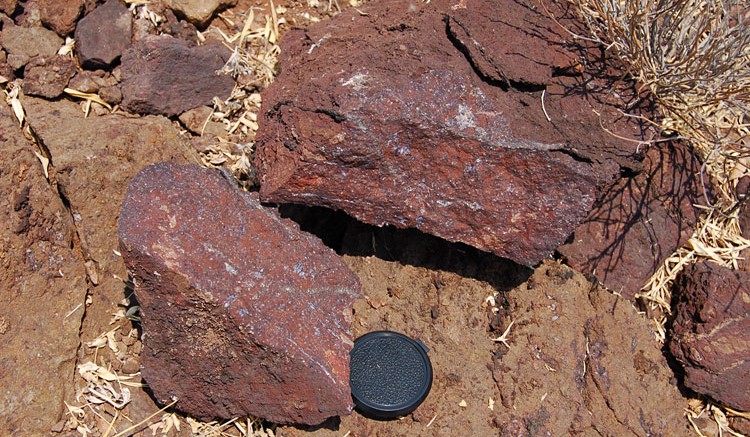Between 2005 and 2008 Namibia Rare Earths (NRE-T, NMREF-O) was focused on exploring for gold and copper mineralization in northwestern Namibia, about 450 kilometres northwest of the capital city of Windhoek.
The Geological Survey of Namibia had documented very high concentrations of heavy rare earths in some dykes in the area and claimed to have found the central core of the carbonatite complex at the main intrusion. Because rare earth elements (REEs) are known to be pathfinders to IOCG deposits, the company prospected over 10,000 square kilometres of ground in the area, known as Lofdal.
Their search for IOCGs yielded nothing of interest, however, so the company shifted gears to concentrate on rare earths in the region. After taking more than 3,400 samples from outcrops in 2008 and 2009, the company realized that the carbonatite complex was a new rare earth mineral district that possibly held a number of rare earth deposits.
Additional surface sampling in 2010 confirmed their initial findings and in 2011 the company completed 9,500 metres of diamond drilling to test a number of targets on the 740-sq.km-property centred on the Lofdal carbonatite complex. What it found was that there was significant rare earth mineralization in all sixteen of its drill targets, some of which it believed contained high levels of the more valuable heavy rare earth elements (HREEs).
The company then decided to focus its drilling on one target it called Area Four, and drilled another 6,000 metres to a maximum vertical depth of 150 metres before completing a resource estimate in September 2012.
The company found the results encouraging. At a cut-off of 0.3% total rare earth oxides, the indicated resource in Area Four stood at 0.90 million tonnes grading 0.62% TREO with 85.6% of it HREEs, and inferred resources of 0.75 million tonnes averaging 0.56% TREO with 85.1% HREE.
Mike Niehuser of Beacon Rock Research in Portland Oregon notes that the resource at Area Four has the highest basket price of any compliant resource of any rare earth deposit in the world due to its high concentration of more valuable heavy rare earths and believes it has significant expansion potential at depth and along strike to the east. A metallurgical study is underway that should help de-risk the project further.
“The completion of a highly credible initial resource program at Area Four in 2012 with a successful metallurgical report may be sufficient to secure an agreement with a qualified joint-venture partner,” he says, adding that the metallurgical study is on schedule to be completed in the first quarter of 2013.
“As opposed to spending millions of dollars on economic studies or completing weak off-take agreements years ahead of potential production,” he adds, “management’s strategy is to assemble an adequate level of information for a qualified joint-venture partner to complete their own due diligence.”
Niehuser argues that this type of agreement would provide the market a clear pathway for the direction of the company. “It would appear that with the completion of an initial resource estimate and metallurgical study, the value creation potential for a partnership will move from the field and the lab, to corporate combination activity in 2013,” he says.
As the company awaits the results of its metallurgical testwork, management has shifted back into exploration mode and in November 2012 reported that exploration drilling in Area Four had intersected rare earth mineralization 200 metres down-dip of the initial resource.
Drill hole 4098 returned 10 metres of 0.44% TREOs with 82.4% HREEs, including 2 metres of 1.34% TREO with 94.1% HREE, at a vertical depth of 350 metres. Hole 4100 cut 0.17% TREO over 19 metres with 50.8% HREE enrichment at a vertical depth of 270 metres.
In addition, eight exploration holes drilled to test a new target about 1.5 km northeast of the initial resource also intersected rare earth mineralization of 0.1%-0.3% TREO over 3-24 metres, with moderate levels of heavy rare earth mineralization ranging from 16% to 52% HREEs. The holes were drilled over a strike length of 450 metres.
More recently, Namibia Rare Earths has discovered two new zones at Area Six, one new zone in Area Five, and higher grades in Area Eight.
The new discoveries reported on Feb. 7 bring the total number at Lofdal to seventeen over a two-year period.
Elsewhere in the country, the company has the Florida exploration permit immediately south of Lofdal and the Marinkas permit, which covers 87 sq km in southern Namibia, about 25 km north of the Orange River.
At presstime in Toronto, Namibia Rare Earths was trading at 20¢per share within a 52-week range of 19.5-50 per share.


Be the first to comment on "Namibia Rare Earths finds more heavies"